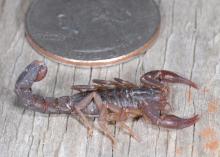Information Possibly Outdated
The information presented on this page was originally released on November 15, 2018. It may not be outdated, but please search our site for more current information. If you plan to quote or reference this information in a publication, please check with the Extension specialist or author before proceeding.
Two scorpion species call Mississippi home
STARKVILLE, Miss. -- While scorpions frequently live in hot and dry areas, at least two scorpion species are at home in Mississippi's often cold and wet climate.
Jerome Goddard, medical entomologist with the Mississippi State University Extension Service, identified the scorpions: Vaejovis carolinianus, commonly called the Southern Devil Scorpion or unstriped scorpion, found only in northeast Mississippi; and Centruroidis vittatus, known as the striped scorpion, found sporadically in central and southern parts of the state.
“The Vaejovis scorpion is primarily found in Tishomingo County,” Goddard said. “Vittatus is more widely distributed, with some spotty records of it being found around Jackson and the Gulf Coast.”
As with scorpions out West, Mississippi scorpions can be found outdoors under rocks or fallen wood. They also find indoor homes where debris is allowed to accumulate.
“Scorpions are arachnids, and they eat insects and other small invertebrates,” Goddard said. “Some scorpions can even attack small vertebrates like tiny lizards.”
Similar to a wasp sting, the scorpion’s venom is painful but not dangerous unless a person has an allergic reaction to it.
Blake Layton, Extension entomologist, said a mature adult Southern Devil Scorpion is about 1.5 inches long. Its sting is for defense and to kill prey.
“Females give birth to live young, which ride on their backs for the first few weeks before striking out on their own,” Layton said.
The best way to control scorpions is to keep them out of the house and away from inhabited areas.
“Make your buildings bug-proof, which means installing door sweeps and weather stripping, caulking cracks, sealing around plumbing and electrical entries, and repairing torn or missing screens,” Layton said. “Next, clean outdoor debris, and, to the extent possible, eliminate places scorpions may use for shelter.”
Scorpion shelter includes piles of rocks, stacks of lumber or firewood, dead limbs and logs, as well as other debris.
“It is a good idea to do these two steps in this order: bug-proofing and then debris cleanup. Otherwise, you could have a bunch of displaced scorpions looking for a home before you get all the potential entry points sealed,” Layton said.
Scorpions are difficult to control with insecticides, but outdoor perimeter sprays that include pyrethroid insectices can be helpful. It is best to hire a professional to deal with heavy infestations.
Goddard said glue boards and sticky traps are good options for catching scorpions indoors.
“When I had family in Iuka, I very often saw scorpions stuck to glue boards set indoors for pest control,” Goddard said.









